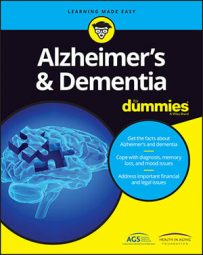Identifying extrapyramidal signs
As the disease advances, some patients may display what is known as extrapyramidal signs including tremors, rigidity, and slowness of movement. This kind of physical symptom may also indicate the development of another condition or a problem with medications interacting.More commonly, patients who exhibit extrapyramidal signs early in the disease are at risk for developing non-Alzheimer's dementia, such as that caused by a vascular accident like a stroke. Parkinson's disease or some antipsychotic drugs like haloperidol (Haldol) may cause the symptoms.
If your loved one has an odd shuffling gait or swings his legs in wide circles from the hip as he walks, have him evaluated immediately. These extrapyramidal symptoms may respond well to treatment if caught early enough.
If you're thinking that extrapyramidal means outside the pyramid, you're almost right. Many of the nerves that control movement and sensation run through a part of the brain stem called the medulla, which is shaped somewhat like a pyramid. The nerves running from the medulla to the spinal cord are called the pyramidal tract, and they control all voluntary muscle movement like walking or raising your hand. Nerves outside of this main bundle are called extrapyramidal and run from a group of brain structures called the basal ganglia.
The extrapyramidal nervous system controls involuntary motor movement like posture, balance adjustments, and non-intentional gross motor movements that are part of a more complex act like walking. Damage to the extrapyramidal nerve system can result in a disruption or impairment of motor ability.Patients with more advanced AD may display extrapyramidal signs; it depends on how the AD progresses in each case. If the neurofibrillary tangles and amyloid plaques that are characteristic of AD invade the basal ganglia, extrapyramidal symptoms follow because the functioning of this part of the brain is disrupted. Remember that if extrapyramidal symptoms occur, these degenerative changes are more likely to happen in the later stages of the disease.
Restlessness
Another significant physical symptom that develops as AD progresses is restlessness. The patient can't seem to sit still for a moment and is constantly pacing around with no real purpose in mind.Restlessness may also manifest as sleep disruption, occurring in as many as 45 percent of all AD cases. Some patients withdraw and sleep almost all the time, while others barely sleep at all. Many families report that their AD patient roams around all night long, making it impossible for other family members to sleep soundly.
Sometimes families have to install special locks high up on doors to the outside to avoid the nighttime wanderer from getting outside and roaming in the night. In some cases, the patient may experience a reversal of their nights and days, sleeping all day and staying awake and active all night. Such day-night reversal can be very burdensome for family caregivers. In addition to physical aggression and incontinence, families cite sleep disturbances as a major reason why they decide to put their loved one in a residential care facility.
Other physical symptoms
The following physical symptoms may also be present in an AD patient, but they generally don't appear until the disease profoundly affects the patient:- Impaired motor ability: Even though muscle function remains intact, the nerve signals that initiate voluntary movement may degrade as AD progresses into the sections of the brain that control these movements. When this happens, your loved one may move more slowly or with a marked degree of uncertainty.
- Difficulty walking.
- Problems with pacing.
- Trouble maintaining balance, resulting in falls.

